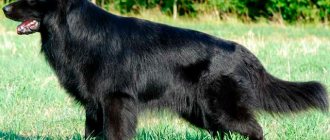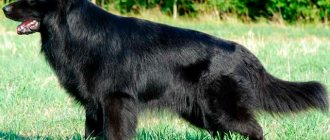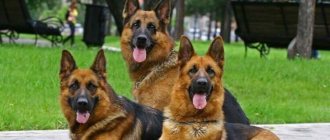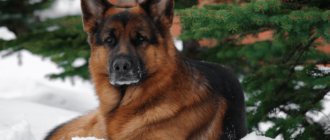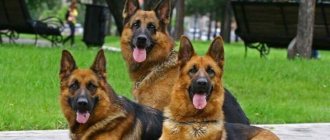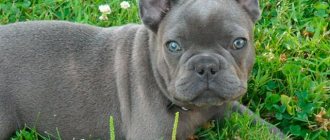Among German shepherds there are representatives of black color. This color is quite rare in this breed and looks very attractive. It is known to occur in only three percent of puppies.
In this article we will talk about what qualities solid-black shepherd dogs have, what parents they can be born from, and how to properly care for them.
History of the Black Shepherd
Until recently, individuals with a charcoal-colored coat were not particularly valued at exhibitions. They were considered defective. Most breeders simply did not want to breed them and allow them to reproduce. Mostly dogs were bred with saddle-back, zone-red, or zone-gray colors.
But the exhibition that took place in 1906 changed everything.
It featured a male named Roland von Stankerburg, who has absolutely dark fur without any other shades. Everyone who was at the show thought that a completely new breed had appeared. But that was not the case. After all, black shepherds are the same as German shepherds, only with a special and very rare coat color.
As a result of the fact that the dark color of the coat of shepherd dogs turned out to be unique and unique, such animals began to be highly valued. Many people who know a lot about dogs of this breed dream of a pet of this color.
Non-standard colors
From time to time, puppies are born with deviations in color (blue, brown or white). These dogs are sterilized and given away as pets. Color should not be a reason for euthanasia.
White color
The partial albinism gene can be carried by a German Shepherd with a strong black coat and mask, but with sandy/gray tan markings. Sometimes such a dog produces fully or partially white puppies.
Considering that a small white spot can be found even on a dark wolf, such markings of a shepherd dog are often ignored (unless this sign extends). Pink claws on your fingers will also tell you about the manifestation of the white spotting gene.
Best articles: 6 Amazing and interesting facts about animals
Brindle color
This type of color is classified as extinct, although at one time (at the founding of the breed) it was almost the main one. The brindle gene is expressed on the tan area, causing black and tan shepherds to have black stripes/markings throughout the tan area (like brindle boxers). The color looks quite attractive, but so far not a single shepherd dog with a brindle zonal color has been presented to the field of view of dog handlers.
Blue and brown colors
Both options are not strictly prohibited, but they contradict the standard due to the incorrect coloring of the nose: in blue and liver shepherd dogs the nose is not black, but brown or gray. However, US breeders are increasingly trying to produce blue and brown "Germans" that have an impressive appearance (with 4 shades in both colors) with silver-yellow eyes.
With the blue gene, the black pigmentation changes to steel gray with the traditional tan color (sometimes with silver notes). With the liver color gene, the black pigment gives way to brown.
Distinctive external features of black shepherds
It is worth noting that black dogs are not only distinguished by their dark shade of hair, but also by other external features.
Let's see what the difference is:
- First of all, they are noticeably larger than their brothers in build. The height of males starts from 60 centimeters and ends at 68 centimeters, weight is limited from 45 to 50 kilograms. The height of female dogs is limited to 55-60 centimeters, and their weight reaches 40 kilograms.
- The fur of these animals is glossy, silky and longer. Black Shepherds have noticeable shaggy hair on their chest and head. It can be compared to the mane of a lion.
Which parents give black puppies?
Amazingly, black German Shepherd puppies can be born to either all-black parents or mixed ones.
The thing is that the dark shade of the coat is recessive and not dominant in individuals of this breed. Therefore, a bitch and a dog can have both zoned-red, black-and-white, and completely charcoal puppies in their litter at the same time.
If the pet's parents were black-haired, and he himself was born completely black, we can assume that his grandparents had the genes for black hair.
To obtain solid black puppies, breeders use a mixture of the blood of the following parents:
- Black male + black female (or vice versa),
- Zonar female + black male (or vice versa),
- Black male + female (provided that the ancestors had a black color),
- Zonar male + female of the same coloring.
These parents may have coal children with different probabilities. Are black puppies always born black?
Grey
Greek and Central Asian, South Russian Shepherd Dogs, Briard - these are the breeds that can have a gray color.
An interesting breed is the Puli, which comes in white, gray, and other colors.
Puli dog
The fur is formed into cords that completely hide her brown eyes. Puli is a very smart and loyal, but also a serious dog.
If she thinks her owner is in danger, she will attack without warning.
The Catalan Shepherd is found in both gray and other colors.
Catalan Shepherd
Her coat is hard, with a thick undercoat, the dog is decorated with a lush collar, mustache, beard, and bangs. The wool is long.
The dog's appearance is very funny, and his character is energetic and cheerful.
The Romanian Mioritic Shepherd is massive, covered with thick white or fine hair, sometimes with different spots. She is surprisingly obedient and extremely affectionate.
Romanian Mioritic Shepherd Dog
Only the owner himself can train her: she “falls in love” with only one person, once and for all. The Romanian Shepherd will never betray its owner, even if he is no longer there.
Are black puppies always born black?
It happens that when a German Shepherd puppy is born, it has a charcoal-colored coat. It would seem that he will be like this throughout his life. But this is a wrong assumption.
What color the pet will finally be can be judged only after 8-9 months of the dog’s life. At this time, the top layer of the “fur coat”, called the adult, will form. Until this time, it is very difficult to predict what the animal will be like in the future.
Long-haired black shepherds
Among dark-colored German shepherds, there are a lot of long-haired representatives of this breed. They have numerous featherings on the sides, limbs, hips, auditory organs, and under the tail. They are also distinguished by lush, tousled hair on the back of the head and on the chest. Such animals shed more often than their relatives.
Until recently, dogs with long hair were not allowed for exhibitions and breeding. But now adjustments have been made to the breed standards, and puppies with long fur are also highly valued at various exhibitions.
The coat of individuals of this subspecies has two layers: a dense, impenetrable undercoat and a long, characteristic hairy part on top.
Description of the breed
The German Shepherd of any color is a strong and well-built dog, but not massive. With a height at the withers of about 53-65 centimeters, the weight of an adult dog reaches 25-40 kilograms, depending on the gender of the animal (males are larger). The main nuances of the breed are the stretched line of the body, developed muscles, and strong bones. Germans have well-defined withers, a smooth top line that merges with the tail. This body type allows dogs to be strong, but also resilient and agile.
Fast and dynamic dog
The back line of the German Shepherd is straight and strong, the upper part of the body itself is strong, muscular, and goes into a short loin. The chest is wide, the forebreast (the most protruding point) is clearly defined. The croup is sloping, flowing into a fairly long and thick, curved tail with good pubescence. The limbs are long, stable, strong, allowing the Germans to move with the creeping characteristic movements of the breed. The front legs and shoulder girdle support the bulk of the animal’s body, and therefore have a special structure: they are parallel to each other, straight, strong and muscular. The hindquarters provide strong propulsion, have pronounced angulations, and a wider stance than the forelimbs.
Shepherd dog maintenance
The black shepherd, like any other representative of this breed, and indeed any pet, needs good maintenance and care. Let's look at how to properly care for a shepherd with charcoal coat in detail:
- It is better to keep the animal in a country house on the street, or in an enclosure. This dog loves freedom and space.
- It is important to provide your pet with a separate sleeping place. This can be a comfortable warm booth or a comfortable bed if the dog lives in the house.
- The shepherd needs to be fed 2 times a day. Nutrition should be balanced and have the right amount of fats, carbohydrates and proteins. The latter are very important for the subspecies of this breed, since these dogs have large muscle mass and build.
- The diet must include raw meat (approximately 60-70 percent per serving), dairy products (not fatty), various vegetables and herbs. As for walks, they should be frequent, up to 3 times a day, and have a fast pace, combined with active games, running over obstacles and jumping.
- It is important not to forget about training and raising your pet.
- Since the dog has thick hair, it needs to be brushed 2 times a week with special brushes and combs. During shedding, this should be done every day.
- It is important to remember the need to disinfect the sleeping area, enclosure and the dog itself.
- It is recommended to bathe your shepherd once every three months with special hypoallergenic care products.
- You must also remember to trim your pet’s nails, if they are not sharpened, and clean the ear canal.
Feeding the dog
The diet of a black shepherd should include natural food or factory-made food (dry and wet food).
Recommended Products:
- lean meat;
- raw eggs;
- dairy products;
- cereals: buckwheat, oatmeal, rice.
Adult dogs cannot digest dairy products. You should not give flour, spicy, sweet or fatty foods. For pets on a natural diet, a vitamin complex must be included in the menu. To prevent diseases and shine the coat in winter, fish oil is introduced into the diet.
Health of Black Shepherds
Particular attention should be paid to the health of the dark German Shepherd.
An animal of this breed is susceptible to diseases such as:
- Colds,
- Tendency to allergies and dermatological diseases,
- joint dysplasia,
- Digestive disorders.
The dog must be taken to the veterinarian for examinations. When the animal has not yet grown to adulthood, it is important to give it the necessary vaccinations and give it additional vitamins, if required.
If the shepherd lives outdoors, you should inspect the animal’s paws every evening for any splinters and thorns. If there are any, they are immediately treated with hydrogen peroxide, brilliant green or iodine. Otherwise, it may lead to inflammation.
Lifespan
With proper care, the dog lives from 10 to 15 years. Health and illness
The German Shepherd is a non-capricious animal regarding diseases. However, the breed is prone to genetic diseases such as:
- Hip dysplasia. It appears mainly in older dogs. Symptoms: drowsiness and lethargy of the pet, lameness. The course of treatment is prescribed depending on the degree of looseness of the joints of the limb.
- Myocardial disease. Dogs aged 5 years and older are at risk. The development of the disease is provoked by the presence of infection in the body, lack of physical activity or insufficient amount of it. Symptoms: respiratory failure, shortness of breath, apathy and cough.
- Inflammation of the organs of the endocrine system. Germans are prone to pancreatitis and other possible inflammations in this area of the digestive system. Signs: sudden weight loss in the dog, chronic stomach upset, hair loss and growth retardation. The doctor prescribes medications for the animal to maintain the level of enzymes in the blood that the damaged gland produces, and vitamins.
- AD (Atopic dermatitis or eczema) is a skin disease in the form of an allergic reaction. The causes of the disease include dust mites, fungus, medications, and contact with another infected dog. Treatment is carried out using antihistamines.
- Falling disease (epilepsy). Consequences of past infections, insect bites, damage to the body’s central nervous system. It manifests itself in the animal’s restless behavior, convulsions, incontinence and increased salivation. Unfortunately, this disease has no cure. All the owner can do is keep the dog in a neutral position.
- Inflammation of the bone substance (panostitis). The risk zone includes babies under one year old. The disease is characterized by inflammation of the tubular bone, where bone marrow is replaced by fibrous tissue. Characteristic signs: lameness, hunger strike, weight loss. Eosinophilic panostitis is treated with painkillers and anti-inflammatory drugs.
- Hemophilia. It is transmitted to puppies from a sick mother or father. Symptoms: spontaneous appearance of bruises, poor blood clotting, swelling of muscle tissue. The owner protects such animals from any bruises and injuries, because the dog can die even from a minor wound. The disease cannot be treated. The blood is stopped by transfusion.
Character and psyche
Some dog breeders have suggested that charcoal German Shepherds are quite aggressive and unfriendly. But this is clearly not the case. They are very fearless and brave, at the same time calm, and have a balanced and stable psycho-emotional system.
These shepherds are very good with small children. In an extreme situation, the “dark” representatives of the breed are able to protect the child and save him. They are very devoted to their owner and are loyal to him until death.
White suit
The German white shepherd breed is not officially recognized - therefore, it should not be owned by those who want to take part in exhibitions and win prizes. White Shepherd puppies are visually similar to the Swiss, with whom they are often confused, but it should be understood that they are completely different breeds.
White Germans differ from other colors in their sensitivity and intelligence - it is completely useless to try to accustom them to serve in the army or police, they are not aggressive and tough enough. But on the other hand, white shepherds are famous for their intelligence and ability to empathize - they understand the mood of the owner and are always ready to support in difficult times. They have a soft, intelligent character and high intelligence, which raises such a dog a step above the rest.
It is important for white shepherds to have appropriate upbringing and training - in addition to physical exercise, it is useful to offer them tasks for intelligence, which develop the intellectual component in such dogs.
In addition, early socialization is recommended for dogs of this species in order to develop their communication skills and the ability to be around unfamiliar people. With appropriate training and education, such a dog can become an excellent guide for a blind person.
Among those factors. which may scare away a potential owner from buying a puppy of this color are worth mentioning: heavy shedding, the need for training and mental exercise, and the need for special socialization.
Training
In addition to proper care and maintenance, a shepherd with dark hair must be trained and educated. It is necessary that it be exposed not only to physical, but also mental stress. After all, the breed was created for work. These are not ornamental animals. Such dogs serve their master well, guarding the house and yard.
Animals of this subspecies are easy to train. It is important to carry out regular training to keep your pet's brain constantly working. You can send your shepherd dog to guard duty courses and a general training course so that the dog can be taught by professionals.
It is also necessary to remember that the pet must not only be obedient in front of the owner, but also behave with dignity in front of strangers. He must be socialized, that is, he must treat other animals and people normally.
How much do puppies cost?
Due to the fact that Coal Shepherds are born quite rarely, they can be quite expensive, unlike dogs of this breed with a different coat color. Their price starts from 55 thousand rubles and reaches 100 thousand rubles.
In the end, we will add that if a person wants to purchase a completely dark German Shepherd puppy, he needs to wait until the dog is 9 months old. Only then can he be completely sure that the puppy is purebred and the color of its coat will not change with age. In addition, any animal is a big responsibility, so you need to think carefully before getting a pet.
What to feed
If you get a German Shepherd, you must clearly understand the rules of its nutrition. After all, this is the basis of keeping an animal. Undereating is as bad as overeating. Therefore, strictly control the amount of food you consume, especially before physical training. The fact is that the anatomical structure of the digestive tract of dogs promotes bending and movement of the stomach during movements. In cases of overeating, this threatens intestinal volvulus.
Important! Experts advise feeding the “Germans” after a street walk
Puppy
When choosing a pet, give preference to those that have already been weaned from their mother. This will make it easier for you to introduce new foods into your diet.
If you have a very small shepherd in your arms, then take into account the rules for feeding it:
- For the first 2 weeks after birth, puppies should drink only breast milk. If for some reason the mother is not present, the natural process will have to be carried out using a pacifier and bottle. The liquid must be heated to 28°C. Plan to feed at the same time and at regular intervals. The puppy should consume 2/3 cup of milk per day.
- From two weeks of age, the daily portion of food is gradually increased to 2 glasses, while reducing the number of feedings (ideally there should be 6).
- When the dog is 1 month old, it can be offered its first complementary foods in small portions. These are porridges, meat, cottage cheese, soups, vegetable purees.
- In the period from 2 to 4 months, the puppy is fed 5 times a day with a daily food intake of 3–3.5 glasses.
- From 4 months, the number of meals is reduced to 4, and the total daily portion is increased to 1 liter.
- When the dog is six months old, it is fed three times a day, feeding about one and a half liters of food.
- One-year-old animals are transferred to two meals a day.
Important! Do not give puppies boiled potatoes. In this form, the root vegetable is poorly digestible
It is best served raw. Moreover, starch has a very beneficial effect on fur.
For puppies, breeders recommend the following products:
- meat (it is better to give it raw, but you cannot switch the animal to this product only);
- offal (can be given from 4–6 months);
- raw beef bones (useful from one and a half months of age, but not recommended after changing baby teeth);
- raw or boiled sea fish without bones (given from 4 months instead of meat, but not often);
- raw egg yolk mixed with porridge or kefir and boiled white;
- cottage cheese, Adyghe cheese, feta cheese, hard cheese;
- dairy products (must be present in the daily diet);
- brown bread (given to one and a half months of age, soaked in bone broth);
- white bread croutons (acceptable from 2 months);
- buckwheat, rice, rolled oats, corn and wheat cereals;
- vegetables (cabbage, beets, carrots, potatoes, cabbage, pumpkin, rutabaga);
- greens (garlic cloves, chopped onions, dill, parsley);
- raw berries, fruits and dried fruits (all seedless berries, as well as grated apples, pears, strawberries, raisins).
Important! As the dog grows, the owner needs to ensure that his pet’s diet does not contain an excess of calcium, as well as vitamins A and D.
